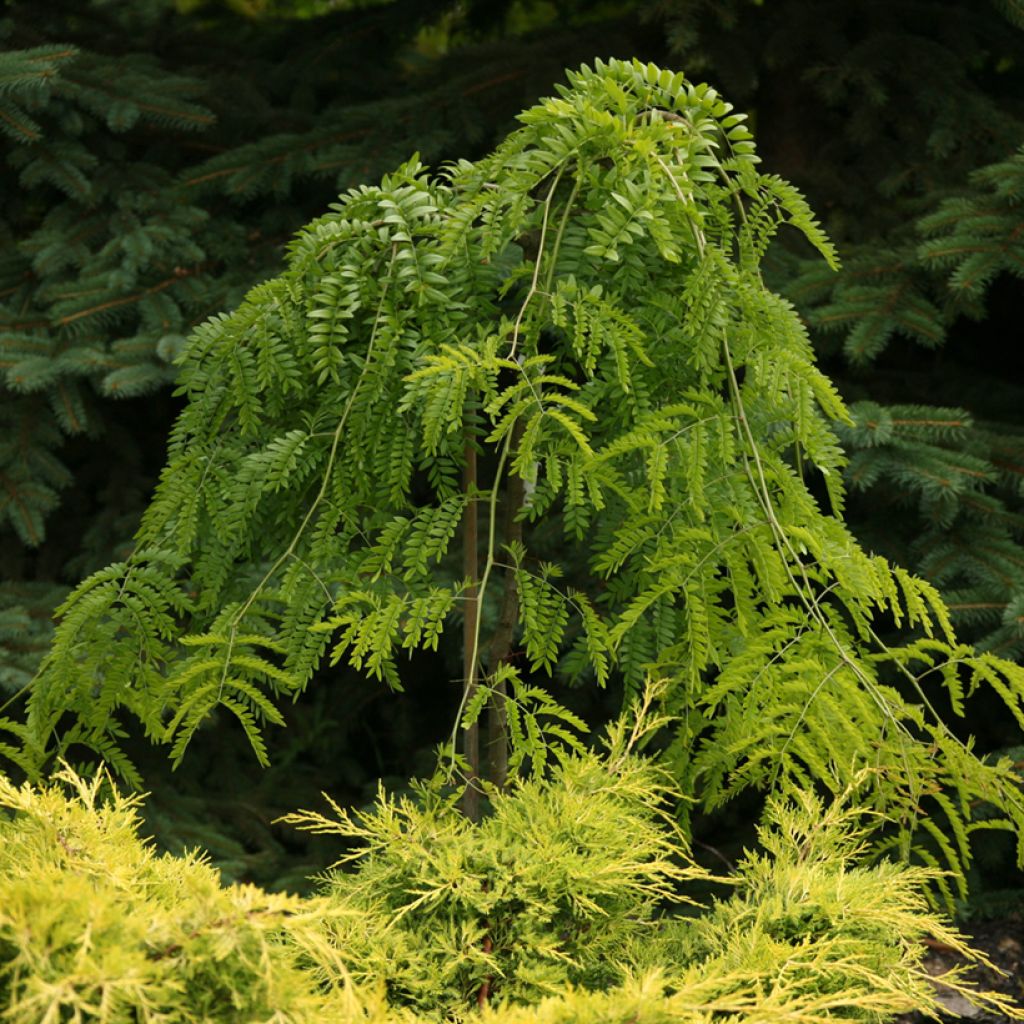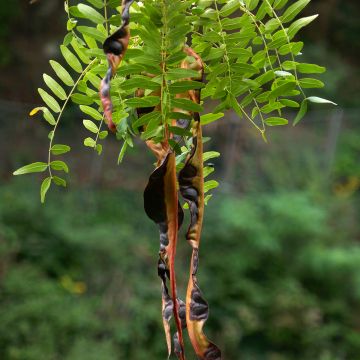

Gleditsia triacanthos var. inermis Emerald Cascade - Thornless Honeylocust
Gleditsia triacanthos var. inermis Emerald Cascade - Thornless Honeylocust
Gleditsia triacanthos var. inermis Emerald Cascade
Honeylocust
Special offer!
Receive a €20 voucher for any order over €90 (excluding delivery costs, credit notes, and plastic-free options)!
1- Add your favorite plants to your cart.
2- Once you have reached €90, confirm your order (you can even choose the delivery date!).
3- As soon as your order is shipped, you will receive an email containing your voucher code, valid for 3 months (90 days).
Your voucher is unique and can only be used once, for any order with a minimum value of €20, excluding delivery costs.
Can be combined with other current offers, non-divisible and non-refundable.
Home or relay delivery (depending on size and destination)
Schedule delivery date,
and select date in basket
This plant carries a 24 months recovery warranty
More information
We guarantee the quality of our plants for a full growing cycle, and will replace at our expense any plant that fails to recover under normal climatic and planting conditions.
Would this plant suit my garden?
Set up your Plantfit profile →
Description
The Gleditsia triacanthos var. inermis 'Emerald Cascade' is a thornless variety of the American honey locust that is known for its beautiful weeping habit and small size. It has large, deciduous leaves that are finely cut and have a bright green colour, turning warm yellow in autumn. This small ornamental tree is best planted as a standalone specimen near a water feature, in a small garden, or in a container on a terrace.
The Gleditsia triacanthos, or American honey locust, is a tree in the Fabaceae family, related to the carob tree, and native to the eastern and central United States (from Nebraska, through Pennsylvania, down to Texas). It grows quickly, especially in moist soil. Young specimens need protection from severe cold, but a mature tree can withstand temperatures well below -15°C. Once well-established, the American honey locust tolerates summer drought. It can tolerate almost any soil type, except excessively acidic soils.
The Gleditsia triacanthos 'Emerald Cascade' is a thornless horticultural selection that develops a more or less regular weeping crown when grafted onto a stem. It has slow growth, and its mature size depends on the height of the rootstock. The tree reaches between 3 and 5 metres in height with a spread of 2.5 to 3.5 metres. Its dark grey bark tends to become shallowly channelled over time. The branches hang down to the ground if not pruned. The foliage appears late in spring and is dense and highly decorative, composed of large leaves divided into numerous leaflets measuring 3 cm long. The foliage colour changes from emerald green to golden yellow in autumn and has a glossy texture that plays beautifully with light, even when viewed through. This variety only produces inconspicuous male flowers in small greenish clusters between June and July. The tree has a deep taproot system, requiring a soil with good depth.
The Gleditsia triacanthos var. inermis 'Emerald Cascade' is a small tree suitable for gardens of all sizes and container cultivation. It can be planted as a focal point. To surround it, choose easy-care ground cover plants such as periwinkle or variegated ground ivy (Glechoma hederacea 'Variegata'). Consider also planting spring bulbs or cyclamen near its base.
One might wonder why thornless American honey locust and its varieties are not more commonly planted in France, which seems to only feature albizia in its gardens, despite it being less hardy and not easier to grow. This is likely due to its insignificant flowering, which is more than compensated for by the splendour of its foliage.
As an ornamental tree and useful plant, Gleditsia has hard and dense reddish-brown wood that is locally used for making posts and railway sleepers, and is also appreciated in cabinetmaking. Its foliage, rich in protein, makes excellent fodder for livestock. This highly adaptable tree, thriving in rich and moist, even poorly drained soil, ultimately tolerates dry, poor, and alkaline soils once established.
Report an error about the product description
Plant habit
Flowering
Foliage
Botanical data
Gleditsia
triacanthos var. inermis
Emerald Cascade
Fabaceae
Honeylocust
Cultivar or hybrid
Other Gleditsia - Honey Locust
View all →Planting and care
The Gleditsia triacanthos 'Emerald Cascade' prefers a sunny location and a rich, well-drained soil. Avoid areas where the wind often blows, as the wood is quite fragile. It adapts to almost all soils, except those that are too acidic or consistently waterlogged. Prepare a deep planting hole or deposit a thick layer of gravel, and mix compost into your garden soil for organic matter. If needed, add sand to lighten heavy soils such as clay. Stake your young plant. You can protect it during the first two winters with a winter cover if your garden is located in a very cold region. Pruning is limited to removing dead branches or shortening any overly long branches at the end of winter. Once well-rooted, this tree is fairly resistant to summer drought.
Planting period
Intended location
Care
Planting & care advice
This item has not been reviewed yet - be the first to leave a review about it.
Similar products
Haven't found what you were looking for?
Hardiness is the lowest winter temperature a plant can endure without suffering serious damage or even dying. However, hardiness is affected by location (a sheltered area, such as a patio), protection (winter cover) and soil type (hardiness is improved by well-drained soil).

Photo Sharing Terms & Conditions
In order to encourage gardeners to interact and share their experiences, Promesse de fleurs offers various media enabling content to be uploaded onto its Site - in particular via the ‘Photo sharing’ module.
The User agrees to refrain from:
- Posting any content that is illegal, prejudicial, insulting, racist, inciteful to hatred, revisionist, contrary to public decency, that infringes on privacy or on the privacy rights of third parties, in particular the publicity rights of persons and goods, intellectual property rights, or the right to privacy.
- Submitting content on behalf of a third party;
- Impersonate the identity of a third party and/or publish any personal information about a third party;
In general, the User undertakes to refrain from any unethical behaviour.
All Content (in particular text, comments, files, images, photos, videos, creative works, etc.), which may be subject to property or intellectual property rights, image or other private rights, shall remain the property of the User, subject to the limited rights granted by the terms of the licence granted by Promesse de fleurs as stated below. Users are at liberty to publish or not to publish such Content on the Site, notably via the ‘Photo Sharing’ facility, and accept that this Content shall be made public and freely accessible, notably on the Internet.
Users further acknowledge, undertake to have ,and guarantee that they hold all necessary rights and permissions to publish such material on the Site, in particular with regard to the legislation in force pertaining to any privacy, property, intellectual property, image, or contractual rights, or rights of any other nature. By publishing such Content on the Site, Users acknowledge accepting full liability as publishers of the Content within the meaning of the law, and grant Promesse de fleurs, free of charge, an inclusive, worldwide licence for the said Content for the entire duration of its publication, including all reproduction, representation, up/downloading, displaying, performing, transmission, and storage rights.
Users also grant permission for their name to be linked to the Content and accept that this link may not always be made available.
By engaging in posting material, Users consent to their Content becoming automatically accessible on the Internet, in particular on other sites and/or blogs and/or web pages of the Promesse de fleurs site, including in particular social pages and the Promesse de fleurs catalogue.
Users may secure the removal of entrusted content free of charge by issuing a simple request via our contact form.
The flowering period indicated on our website applies to countries and regions located in USDA zone 8 (France, the United Kingdom, Ireland, the Netherlands, etc.)
It will vary according to where you live:
- In zones 9 to 10 (Italy, Spain, Greece, etc.), flowering will occur about 2 to 4 weeks earlier.
- In zones 6 to 7 (Germany, Poland, Slovenia, and lower mountainous regions), flowering will be delayed by 2 to 3 weeks.
- In zone 5 (Central Europe, Scandinavia), blooming will be delayed by 3 to 5 weeks.
In temperate climates, pruning of spring-flowering shrubs (forsythia, spireas, etc.) should be done just after flowering.
Pruning of summer-flowering shrubs (Indian Lilac, Perovskia, etc.) can be done in winter or spring.
In cold regions as well as with frost-sensitive plants, avoid pruning too early when severe frosts may still occur.
The planting period indicated on our website applies to countries and regions located in USDA zone 8 (France, United Kingdom, Ireland, Netherlands).
It will vary according to where you live:
- In Mediterranean zones (Marseille, Madrid, Milan, etc.), autumn and winter are the best planting periods.
- In continental zones (Strasbourg, Munich, Vienna, etc.), delay planting by 2 to 3 weeks in spring and bring it forward by 2 to 4 weeks in autumn.
- In mountainous regions (the Alps, Pyrenees, Carpathians, etc.), it is best to plant in late spring (May-June) or late summer (August-September).
The harvesting period indicated on our website applies to countries and regions in USDA zone 8 (France, England, Ireland, the Netherlands).
In colder areas (Scandinavia, Poland, Austria...) fruit and vegetable harvests are likely to be delayed by 3-4 weeks.
In warmer areas (Italy, Spain, Greece, etc.), harvesting will probably take place earlier, depending on weather conditions.
The sowing periods indicated on our website apply to countries and regions within USDA Zone 8 (France, UK, Ireland, Netherlands).
In colder areas (Scandinavia, Poland, Austria...), delay any outdoor sowing by 3-4 weeks, or sow under glass.
In warmer climes (Italy, Spain, Greece, etc.), bring outdoor sowing forward by a few weeks.






















































